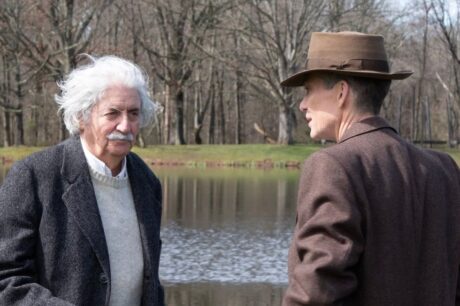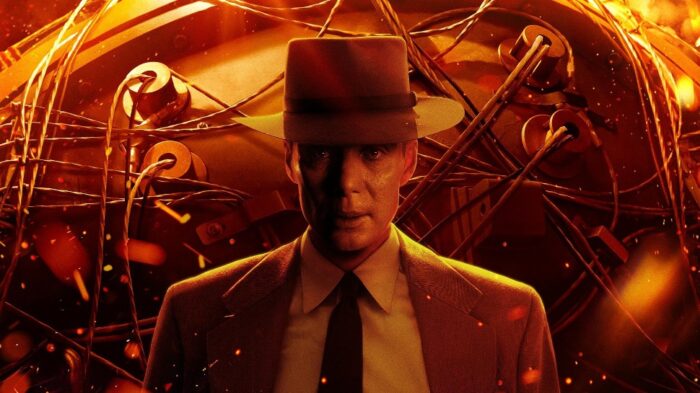Published in Japan Forward 14th August 2023
An atom bomb has just been dropped on the city of Hiroshima. In a lecture room in Los Alamos, home of the Manhattan Project which created this new weapon, there is wild excitement. Project Director J. Robert Oppenheimer stands before the crowd and pronounces it a great day for America.
Flags are waved. One woman looks almost maddened with triumph. Then the scene changes to black and white, signalling Oppenheimer’s subjective experience. The room starts to shake and there are ominous flashes and rumbles. He realises that the world has changed forever, that from now on unimaginable carnage will always be a button push away.
The movie “Oppenheimer”, which tells the story of the so-called “father of the atom bomb”, has become a huge worldwide hit. It has already earned box office receipts of over $550 million since its first screening in July, a few days before the 78th anniversary of the Trinity test that ushered in the era of nuclear weapons.
That date made it impossible for the film to open in Japan at the same time as the rest of the world, given the sombre annual commemorations of the bombing of Hiroshima and Nagasaki that take place in early August, followed by the anniversary of the end of the war and the “O-Bon” festival of the dead. Yet there is nothing disrespectful of Japanese sensitivities in “Oppenheimer”.
Wisely, Nolan does not attempt to capture the devastation caused by the atom bombing through special effects or newsreel, which could indeed have appeared exploitative. Instead, he has a character recount the terrible damage done to the bodies of children and young women, leaving the audience to use its imagination.
Why has the film been so successful? One reason is that it is an outstanding example of contemporary cinematic art, superbly constructed and acted. The three hour running time zips by without longueurs. Another reason, surely, is that the issue of weapons of mass destruction, which had seemed less relevant after the end of the Cold War, is very much with us today. We are living in Oppenheimer’s world.

Oppenheimer with Einstein
The decision to drop the bomb has generated a great deal of controversy over the years. It was originally New Left academics like Gar Alperovitz who cast doubt on the justification for using nuclear weapons. Interestingly, in recent years some voices from the opposite side of the political spectrum have come to agree.
In 2020, John Denson of the libertarian Mises Institute wrote “Japanese leaders, both military and civilian, including the emperor, were willing to surrender in May of 1945 if the emperor could remain in place and not be subjected to a war crimes trial… After the bombs were dropped on August 6 and 9 of 1945, and their surrender soon thereafter, the Japanese were allowed to keep their emperor on the throne.”
Likewise, Peter Van Buren, writing last year in the conservative Spectator magazine, states that the “Hiroshima myth”- that the bomb was the only alternative to a land invasion that would have cost millions of lives – was manufactured in the late 1940s as an antidote to John Hershey’s reportage of the bomb’s human consequences.
Nolan’s film handles the issue with a great deal of nuance. On one hand, President Harry Truman declares that his advisors are certain that the Japanese will never surrender. Yet well before the bomb is dropped, one of the Los Alamos scientists comments that Japan has already lost, as if it is an obvious fact.
Oppenheimer himself is given a prescient line of dialogue in which he posits that the carnage will be so terrible that such a weapon would never be used again. M.A.D. (Mutually Assured Destruction) certainly worked during the era of superpower confrontation, but will it be as effective when weapons of mass destruction are in the hands of theocratic states, non-state actors and dictators with nothing to lose?
Oppenheimer is the figure that all the action revolves around, yet he remains hard to sympathize with or understand. Born into great wealth and privilege – he was given a 28 foot yacht for his sixteenth birthday – he had a brilliant mind. As the film shows, he was capable of reading Sanskrit and teaching himself enough Dutch in a matter of weeks to deliver a physics lecture. Well-versed in the arts and literature, he named the Trinity test in tribute to a favourite poem by John Donne.
He was also dangerously impulsive. One of the first scenes in the film has him attempting to murder his tutor at Cambridge University by means of an apple spiked with cyanide, apparently a real event. He was already severely depressed and undergoing Jungian psychoanalysis at the time. Later, we see him and his wife transferring their baby to a friend because its crying had got on their delicate nerves.
The film depicts Oppenheimer as sympathetic to communism, but a patriot at heart. When a friend at a Christmas party mentions an underground route for getting atomic secrets to Moscow, he responds “that would be treason”. Yet, it is no surprise that his security pass was withdrawn once the Cold War started. Many of his associates were card-carrying members of the American Communist Party, including his lover, his brother and his sister-in-law. Oppenheimer’s own wife was a former member.
No doubt, several would have been attracted by the emphasis on antiracism and workers’ rights, but the party was no Eurocommunist-type middle-of-the-road outfit. It danced to Stalin’s tune. When the Nazi-Soviet pact was signed in 1939, there was no more talk about fighting fascism. “Peace” was the slogan, though members were required to support the unprovoked Soviet invasion of Poland, part of the secret deal between Stalin and Hitler. Some were also involved in underground activities, as delineated in the film’s Christmas party scene.
The process by which Oppenheimer is stripped of his security clearance in 1954 – thereby ending his career as a top government advisor – is manifestly unfair, but the script gives the bullying adversary lawyer some pointed criticism of his inconsistencies. Why, the lawyer thunders, does Oppenheimer still justify the mass killing of Japanese civilians while advocating disarmament with the Soviet Union? What does he really believe in? Oppenheimer’s response is silence.
Ambivalent testimony is given by General Leslie Groves, the man who picked Oppenheimer to head the Manhattan Project. When asked if he would approve Oppenheimer’s security clearance now, he answers in the negative – then adds, as an aside, that he would not give clearance to any of the other nuclear scientists on the project either.
We know now that the Manhattan Project was compromised by several Soviet-sympathizing scientists. The most notorious and the only one featured in the film is Klaus Fuchs who spent nine years in jail in Britain for espionage, then moved to East Germany where he enjoyed a long and illustrious career. Some say that included instructing Mao Zedong’s China in nuclear weapons development. History never ends.
The source book for Nolan’s film is “American Prometheus” by Kai Bird and Martin J. Sherwin. Prometheus is the god who stole fire from the other gods and gave it to humans. As punishment, he was chained to a rock where an eagle gnawed his liver for all eternity. Oppenheimer had it easier, spending time sailing around the Caribbean and eventually receiving an award from President Johnson.
Genius, victim, hero, fool, egotist, communist, patriot, confused soul, or all of the above – Nolan’s film leaves it up to you to make up your mind. Hopefully, Japanese audiences will have the same opportunity before too long.
